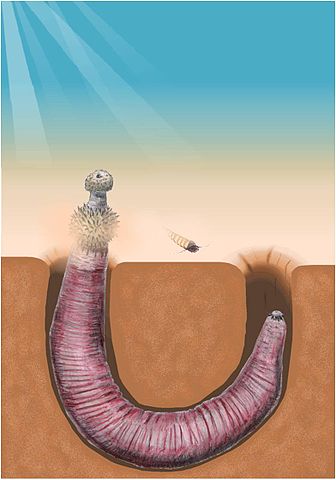|
|
Scalidophora |
| Scalidophora |
Priapozoa |
Scalidophora: Priapozoa
Taxa on This Page
- Priapozoa
Descriptions
Priapozoa (incl. Archaeopriapulida) : Ottoia, Palaeoscolex, Priapulus etc
Phylogeny: monophyletic clade of stem and crown Priapulids; likely to be synonymous with Scalidophora or even Ecdysozoa as a whole, however a reduced definition, e.g. LCA of Ottoia and Priapulus and all its descendents, may mean the clade can still be retained. It is not clear whether or not some or all the palaeoscolecids would be included in this definition MAK120422
Comments: Priapozoa is here used to refer both to stem group Priapulids and associated taxa such as palaeoscolecidans that are classed with them, and extant priapulids and their immediate relatives. Most authors supporting this affinity have simply referred to palaeoscolecidans as "priapulids". The modern priapulids are a small, well-defined group of worms, while the various Palaeozoic taxa regarded as stem-priapulids show a much higher diversity of body plans (many of them, for instance, were far more elongate than any living priapulid, while no living priapulid possesses a dermal armour like that of palaeoscolecidans). adapted from CKT080122
In distinguishing early priapozoans from modern taxa, the paraphyletic term Archaeopriapulida might be used. This includes the assemblage of priapulid-like worms known from Cambrian lagerstatte (Ancalagon, Fieldia, Louisella, Ottoia, Selkirkia, etc). They may or may not be closely related to the palaeoscolecids. Despite a remarkable morphological similarity modern cousins, they fall outside of the priapulid crown group, which is not unambiguously represented in the fossil record until the Carboniferous. - adapted from Wikipedia
In any case, Priapozoa may simply turn out to be synonymous with Scalidophora or even Ecdysozoa. Dzik and Krumbiegel (1989) suggest a general priapulid grade as ancestral to panarthropods. Budd and Jensen 2000, Budd 2001, and Conway Morris & Peel 2010 propose a palaeoscolecid-like form as the common ecdysozoan ancestor; although this hypothesis has been rejected by Harvey et al 2010 on morphological cladistic grounds. Dong et al 2004 fig 3a features a cladogram in which some Cambrian priapozoans are basal Scalidophora, Harvey et al 2010 arrives at a somewhat different topology. The discovery of the early cambrian transitional form Mureropodia, with both priapozoan and lobopod (basal panarthropod) characteristics (Vintaned Gamez et al 2011), supports the hypothesis that panarthropods, and hence all derived ecdysozoa, evolved from a priapulan-like ancestor. MAK120422
 Life restoration of Ottoia prolifica in natural environment with the hyolith Haplophrentis, a food source (Conway Morris 1977);. Ottoia was about 8 cm in length; it is a common representative of the Burgess shale fauna.
Life restoration of Ottoia prolifica in natural environment with the hyolith Haplophrentis, a food source (Conway Morris 1977);. Ottoia was about 8 cm in length; it is a common representative of the Burgess shale fauna.